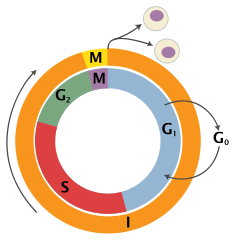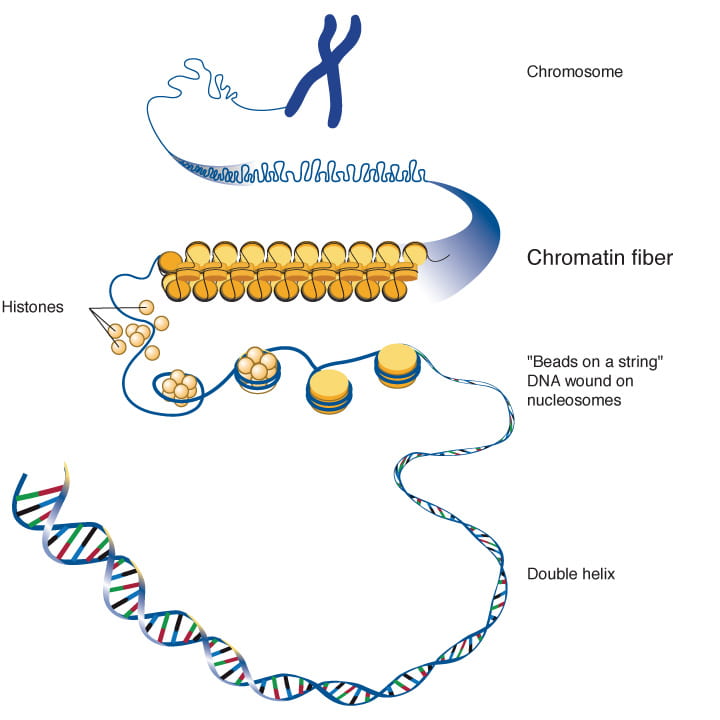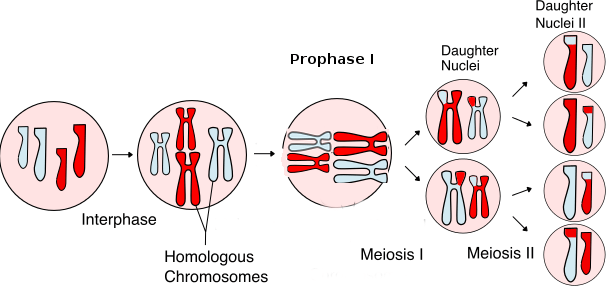The Products Of Mitosis Are
Learning Objectives
- Describe the chromosomal makeup of a cell using the terms chromosome, sister chromatid, homologous chromosome, diploid, haploid, and tetrad
- Recognize the function and products of mitosis and meiosis
- Compare and dissimilarity the behaviors of chromosomes in mitosis and meiosis
- Recognize when cells are diploid vs. haploid
- Predict Dna content of cells in unlike phases of mitosis and meiosis
- Recall and describe the phases of the cell cycle
- Relate the jail cell bicycle stages to changes in Deoxyribonucleic acid content
The Cell Division Cycle

Cell division cycle, effigy from Wikipedia. Cells that cease dividing go out the G1 stage of the cell wheel into a and so-chosen G0 country.
Cells reproduce genetically identical copies of themselves past cycles of cell growth and division. The cell bike diagram on the left shows that a jail cell division cycle consists of iv stages:
- G1 is the period after jail cell division, and before the get-go of Deoxyribonucleic acid replication. Cells grow and monitor their environs to make up one's mind whether they should initiate another circular of cell sectionalization.
- S is the period of DNA synthesis, where cells replicate their chromosomes.
- G2 is the flow between the end of DNA replication and the start of jail cell division. Cells bank check to make sure Dna replication has successfully completed, and make whatsoever necessary repairs.
- M is the actual menstruum of prison cell division, consisting of prophase, metaphase, anaphase, telophase, and cytokinesis.
Chromosomes
Chromosomes were commencement named by cytologists viewing dividing cells through a microscope. The modern definition of a chromosome now includes the part of heredity and the chemical composition. A chromosome is a DNA molecule that carries all or part of the hereditary information of an organism. In eukaryotic cells, the Deoxyribonucleic acid is packaged with proteins in the nucleus, and varies in structure and appearance at different parts of the prison cell cycle.
Chromosomes condense and go visible by lite microscopy every bit eukaryotic cells enter mitosis or meiosis. During interphase (G1 + S + G2), chromosomes are fully or partially decondensed, in the form of chromatin, which consists of Dna wound around histone proteins (nucleosomes).

In G1, each chromosome is a single chromatid. In G2, after DNA replication in Due south stage, every bit prison cell enter mitotic prophase, each chromosome consists of a pair of identical sis chromatids, where each chromatid contains a linear DNA molecule that is identical to the joined sister. The sis chromatids are joined at their centromeres, equally shown in the image below. A pair of sister chromatids is a single replicated chromosome, a single packet of hereditary information.

Homo karyotype "painted" using fluorescent DNA probes. These mitotic chromosomes each consist of a pair of sister chromatids joined at their centromeres. The images of the homologous chromosome pairs (e.one thousand., 2 copies of chromosome one) accept been lined up side by side to each other. Image from Bolzer et al., (2005) Three-Dimensional Maps of All Chromosomes in Human Male Fibroblast Nuclei and Prometaphase Rosettes. PLoS Biol 3(5): e157 DOI: 10.1371/journal.pbio.0030157
Ploidy
Humans are diploid, meaning we have two copies of each chromosome. Nosotros inherited one copy of each chromosome from other mother, and ane copy of each from our male parent. Gametes (sperm cells or egg cells) are haploid, pregnant that they have only one complete set of chromosomes.
Chromosomes that do not differ between males and females are called autosomes, and the chromosomes that differ between males and females are the sexual practice chromosomes, X and Y for most mammals. Humans most commonly have 22 pairs of autosomes and i pair of sexual practice chromosomes (XX or XY), for a total of 46 chromosomes. Nosotros say that humans take 2N = 46 chromosomes, where Due north = 23, or the haploid number of chromosomes.
Cells with consummate sets of chromosomes are called euploid; cells with missing or extra chromosomes are called aneuploid. The nigh common aneuploid status in people is variation in the number of sex chromosomes: XO (having just one copy of the X), 30, or XYY. Having no X chromosome results in early embryonic death.
The two copies of a particular chromosome, such as chromosome 1, are chosen homologous.The karyotype prototype above shows the homologous pairs for all the autosomes. Homologous chromosomes are non identical to each other, unlike sister chromatids. They oftentimes have different variants of the same hereditary information – such equally blue eye color vs brown middle color, or blood type A versus blood type B.
Mitosis
Mitosis produces two daughter cells that are genetically identical to each other, and to the parental cell. A diploid cell starts with 2N chromosomes and 2X DNA content. After DNA replication, the cells is still genetically diploid (2N chromosome number), but has 4X DNA content because each chromosome has replicated its Deoxyribonucleic acid. Each chromosome at present consists of a joined pair of identical sis chromatids. During mitosis the sis chromatids separate and become to opposite ends of the dividing cell. Mitosis ends with 2 identical cells, each with 2N chromosomes and 2X DNA content. All eukaryotic cells replicate via mitosis, exceptgermline cells that undergo meiosis (run across below) to produce gametes (eggs and sperm).
- prophase – chromosomes condense; each chromosome consists of a pair of identical sister chromatids joined at the centromere.
- metaphase – chromosomes line up at the middle of the cell, along the plane of jail cell division, pushed and pulled by microtubules of the spindle apparatus
- anaphase – sister chromatids carve up and migrate towards opposite ends of the cell
- telophase – chromatids cluster at reverse ends of the cell and brainstorm to decondense
- cytokinesis – the membrane pinches in to divide the 2 daughter cells
Here is a simplified diagram illustrating the overall process and products of mitosis:

Source: Wikimedia Commons (https://eatables.wikimedia.org/wiki/File:MajorEventsInMeiosis_variant_int.svg)
Questions or points to ponder or annotation about the figure above (answers at bottom of page):
- are the two daughter cells the aforementioned or unlike from each other, and from the parent cell at the start?
- why does the cartoon illustration of the chromosomes change (from a single rod to joined double rods) afterward DNA replication, and again (back to single rods) during mitosis?
- does the effigy bear witness ii different chromosomes or a single pair of homologous chromosomes?
- can haploid cells undergo mitosis? what virtually triploid cells (cells that take 3N chromosomes)?
This animation beneath shows the packaging of DNA and condensation of chromosomes as a cell undergoes mitosis.
The video narration has a major fault at time 1:22: chromosomes be throughout the entire cell cycle (at all times in a prison cell'due south life); they are visible in their condensed course simply during mitosis and meiosis.
Meiosis
This is a special sequence of ii cell divisions that produces haploid gametes from diploid germline cells. Information technology starts with a diploid cell that has undergone chromosomal Dna replication: 2N chromosomes, 4X DNA content. Two successive divisions, with no additional DNA replication, results in 4 haploid gametes: 1N chromosomes, 1X Deoxyribonucleic acid content.
NOVA has a good interactive side-by-side comparison of mitosis and meiosis on this folio: How cells separate
Meiosis sets the stage for Mendelian genetics. Students demand to know that most of the genetics action occurs in the first meiotic division:
- homologous chromosomes pair up and align stop-to-end (synapsis) in prophase I
- crossing over occurs between homologous chromosomes in prophase I, before chromosomes line upwardly at the metaphase plate
- homologous chromosomes separate to daughter cells (sis chromatids do not dissever) in the first sectionalization, creating haploid (1N) cells
- the separation of each pair of homologous chromosomes occurs independently, so all possible combinations of maternal and paternal chromosomes are possible in the two daughter cells – this is the ground of Mendel'due south Police force of Independent Assortment
- the kickoff division is when daughter cells become functionally or genetically haploid
The last betoken appears to be the most difficult for students to grasp. Consider the X and Y chromosomes. They pair in prophase I, then separate in the get-go sectionalization. The daughter cells of the kickoff meiotic division have either an 10 or a Y; they don't have both. Each cell at present has only one sex chromosome, like a haploid cell.
One way of thinking almost ploidy is the number of possible alleles for each factor a cell can have. Right after meiosis I, the homologous chromosomes accept separated into different cells. Each homolog carries one copy of the gene, and each cistron could be a different allele, simply these two homologs are at present in 2 different cells. Though it looks like there are ii of each chromosome in each cell, these are duplicated chromosomes; ie, it is ane chromosome which has been copied, so in that location is simply i possible allele in the cell (just two copies of information technology).
The second meiotic division is where sister (duplicated) chromatids carve up. It resembles mitosis of a haploid cell. At the showtime of the second division, each prison cell contains 1N chromosomes, each consisting of a pair of sis chromatids joined at the centromere.
Here is a simplified diagram illustrating the overall process and products of meiosis:

Meiosis Overview from Wikipedia past Rdbickel
And here is a video that walks through the steps of meiosis:
Information technology is very important that you recognize how and why cells get haploid afterwards meiosis I.
To ostend for yourself that y'all understand meiosis, work through one or more of these interactive tutorials:
- The U. Arizona Cell Biological science Projection's Meiosis tutorial has a click-through animation of meiosis, with 10 thought-provoking problem questions.
- Jung Choi's interactive flash tutorial, programmed past Pearson, uses human being chromosome 7, with wild type and cystic fibrosis alleles for CFTR, to rail segregation through meiosis, with and without crossing over: Meiotic Segregation tutorial
Chromosomes, chromatids, what is the difference and how many chromosomes are there at different times of the cell wheel and after mitosis and meiosis?
Chromosomes by definition contain the DNA that makes up the fundamental genome of the cell. In a prokaryote, the genome is usually packaged into one round chromosome consisting of a round DNA molecule of a few million base pairs (Mbp). In eukaryotes, the genome is packaged into multiple linear chromosomes, each consisting of a linear DNA molecule of tens or hundreds of Mbp. Chromosomes exist at all different phases of the prison cell cycle. They condense and become visible to lite microscopy in prophase of mitosis or meiosis, and they decondense during interphase, in the form of chromatin (DNA wrapped around nucleosomes, similar "beads on a string").
The chromosome number, Northward, in eukaryotes, refers to the number of chromosomes in a haploid cell, or gamete (sperm or egg cell). Diploid cells (all the cells in our body except our gametes) take 2N chromosomes, because a diploid organism is created by union of 2 gametes each containing 1N chromosomes. In terms of chromosome number (ploidy), it'due south useful to think of chromosomes as packages of genetic data. A pair of sister chromatids is one chromosome because it has genetic information (alleles) inherited from merely one parent. A pair of homologous chromosomes, each consisting of a single chromatid in a daughter cell at the end of mitosis, has alleles from the father and from the mother, and counts every bit 2 chromosomes.
This chromosome number stays the same after chromosome replication during South stage: each chromosome inbound cell division now consists of a pair of sister chromatids joined together at the centromere. So in mitosis, the sister chromatids of each chromosome carve up, so each daughter cell receives one chromatid from each chromosome. The upshot of mitosis is 2 identical girl cells, genetically identical to the original prison cell, all having 2N chromosomes. So during a mitotic prison cell cycle, the DNA content per chromosome doubles during Due south phase (each chromosome starts as one chromatid, so becomes a pair of identical sister chromatids during S phase), but the chromosome number stays the same.
A chromatid, so, is a single chromosomal DNA molecule. The number of chromatids changes from 2X in G1 to 4X in G2 and back to 2X, but the number of chromosomes stays the same.
The chromosome number is reduced from 2N to 1N in the outset meiotic division, and stays at 1N in the 2d meiotic division. Considering homologous chromosomes separate in the first division, the daughter cells no longer take copies of each chromosome from both parents, so they accept haploid genetic information, and a 1N chromosome number. The 2nd meiotic segmentation, where sister chromatids split up, is like mitosis. Chromosome number stays the same when sister chromatids separate.
Using the information above, compare these two simplified diagrams of mitosis and meiosis to visualize why cells are haploid after meiosis I. Specifically, compare the chromosomes in cells at the stop of mitosis vs the finish of meiosis I, recognizing that the diagram of mitosis tracks just a single pair of homologous chromosomes, whereas the diagram of meiosis tracks two pairs of homologous chromosomes (ane long chromosome and brusk chromosome):


Meiosis Overview from Wikipedia by Rdbickel
The video below is geared toward a high school audience, but it does nowadays a helpful way for recognizing how many chromosomes are present in a prison cell (and thus the ploidy level of that jail cell). While watching, encounter if yous tin can recognize why the products of meiosis 1 are haploid cells:
Answers to questions about the mitosis figure:
- The ii daughter cells are the same as each other, and same equally the parental cell
- Each rod represents a chromatid, and Dna replication results in two sis chromatids joined at their centromeres. Mitosis separates the sis chromatids.
- A unmarried pair of homologous chromosomes. Scarlet and bluish are chromosomes inherited from the male and female parents.
- Any cell tin divide past mitosis – haploid, triploid, even aneuploid cells.
The Products Of Mitosis Are,
Source: https://bioprinciples.biosci.gatech.edu/module-4-genes-and-genomes/4-1-cell-division-mitosis-and-meiosis/
Posted by: gibsonyessund.blogspot.com


0 Response to "The Products Of Mitosis Are"
Post a Comment